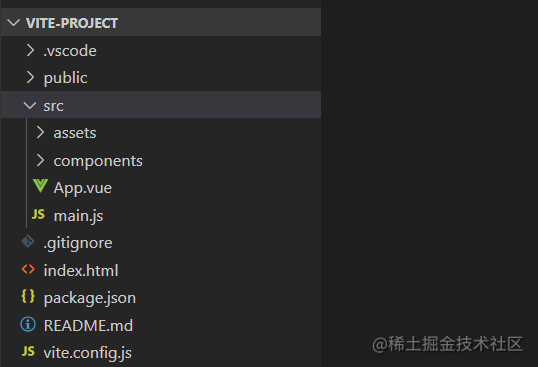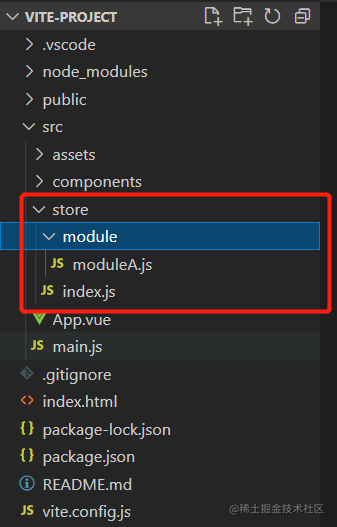相信现在有很多人在用Vue3.0开发项目,但是很多时候没有机会从零开始搭建一个项目,毕竟只有负责人才会有机会将框架给我们搭建出来,然后我们在此基础上进行业务迭代、模块开发,今天就一起来从零搭建一个Vue3.0的最小原型系统,让人人都具备从零开启一个项目的能力。
一、 项目初始化
既然用Vue3.0构建最小原型系统,那么肯定要用尤大的最新构建工具Vite来进行项目的初始化,初始化指令如下所示:
npm init vite@latest
初始化后的目录结构如下所示:

注:前面已写了Vite相关文章,可点开链接阅读巩固好记性不如烂笔头——Vite篇
二、引入UI框架
Vite已经帮助我们完成了项目的初始化,下一步就是引入UI框架,毕竟UI框架帮助我们造了很多轮子,省去了很多工作,提高开发效率。在Vue3.0中,用的比较多的UI框架有Element Plus,下面就一步步引入该UI框架。
- 安装element-plus包
npm install element-plus -S
- 在main.js文件中全局引入
import { createApp } from 'vue'
import App from './App.vue'
// 引入element-plus包
import ElementPlus from 'element-plus';
// 引入对应的样式
import 'element-plus/theme-chalk/index.css';
const app = createApp(App);
app
.use(ElementPlus)
.mount('#app')
- 全局引入后即可在对应的组件中使用
注:除了全局引入组件外,还可以引入部分组件,从而减少打包体积。
三、引入状态管理器Vuex
作为Vue的配套内容,Vuex必不可少,其采用集中式存储管理应用的所有组件的状态,并以相应的规则保证状态以一种可预测的方式发生变化。下面就一起引入Vuex。
- 安装对应的vuex包
npm install vuex -S
- 在文件夹下建立对应的文件目录,按如下指令执行即可构建其最简单结构
cd ./src
mkdir store
cd ./store
touch index.js
mkdir ./module
cd ./module
touch moduleA.js

- 在建立好目录结构后,按照如下文件即可实现对应文件中的内容
(1) index.js文件
// index.js文件
import {createStore} from "vuex";
import {moduleA} from "./module/moduleA";
export const store = createStore({
// Vuex允许将store分割成模块(module),每个模块拥有自己的state、mutation、action、getter、甚至是嵌套子模块
// 访问moduleA的状态:store.state.moduleA
modules: {
moduleA
}
});
(2)moduleA.js文件
// module/moduleA.js文件
// 对于模块内部的mutation和getter,接收的第一个参数是模块的局部状态对象
// 对于模块内部的action,局部状态通过context.state暴露出来,根节点状态则为context.rootState
// 对于模块内部的getter,根节点状态会作为第三个参数暴露出来
// 在带命名空间的模块内访问全局内容
// 如果希望使用全局state和getter,rootState和rootGetters会作为第三和第四个参数传入getter,也会通过context对象的属性传入action
// 若需要在全局命名空间内分发action或提交mutation,将{root: true}作为第三个参数传给dispatch或commit即可。
export const moduleA = {
// 默认情况下,模块内部的action、mutation和getter是注册在全局命名空间的,如果希望模块具有更高的封装度和复用性,可以通过添加namespaced:true的方式使其成为带命名空间的模块
namespaced: true,
state: {
testState1: 'xxxx',
testState2: {
a: 0,
b: 1
},
testState3: 0
},
// 有的时候需要从store中的state中派生出一些状态,此时可以将该部分抽象出一个函数供多处使用。
// Vuex允许在store中定义getter,像计算属性一样,getter的返回值会根据它的依赖被缓存起来,且只有当他的依赖值发生了改变才会被重新计算
getters: {
// getter接收state作为其第一个参数
testGetter1: state => {
return state.testState1 + state.testState3;
},
// getter可以接受其他getter作为第二个参数
testGetter2: (state, getters) => {
return getters.testGetter1.length;
}
},
// 更改Vuex的store中的状态的唯一方法是提交mutation,每个mutation都有一个字符串的事件类型和一个回调函数,该回调函数接收state作为第一个参数,提交的载荷作为第二个参数
// 以相应的type调用store.commit方法来触发相应的回调函数
// Mutation必须是同步函数
mutations: {
testMutation1(state) {
// 变更状态
state.testState3++;
},
// 第二个参数是载荷
testMutation2(state, payload) {
state.testState1 += payload.content;
}
},
// Action提交的是mutation,而不是直接变更状态
// Action可以包含任意异步操作
// Action函数接受一个与store实例具有相同方法和属性的context对象,因此可以调用context.commit提交一个mutation,或者通过context.state和context.getters来获取state和getters。
// Action通过store.dispatch方法触发
actions: {
testAction1(context) {
setTimeout(() => {
context.commit('testMutation1');
}, 1000);
},
testAction2({commit}, payload) {
setTimeout(() => {
commit({
type: 'testMutation2',
content: payload.content
});
}, 1000);
}
}
};
- 然后在main.js文件中引入该部分内容
// ……
import {store} from './store';
const app = createApp(App);
app
.use(store)
.use(ElementPlus)
.mount('#app')
- 然后在对应组件中进行使用,具体详细使用内容可以看此处内容
四、引入路由Vue-Router
Vue Router 是 Vue.js 官方的路由管理器。它和 Vue.js 的核心深度集成,让构建单页面应用变得易如反掌,下面就在项目中引入Vue-Router。
- 安装对应的vue-router包
npm install vue-router@4 -S
- 在文件夹下建立对应的文件目录,按如下指令执行即可构建其最简单结构
cd ./src
mkdir router
cd ./router
touch index.js
- 在index.js文件中完善对应的内容
import {createRouter, createWebHashHistory} from 'vue-router';
const routes = [
{
path: '/',
redirect: '/component1'
},
{
path: '/component1',
name: 'component1',
component: () => import('../components/Component1.vue')
},
{
path: '/component2',
name: 'component2',
component: () => import('../components/Component2.vue')
}
];
const router = createRouter({
history: createWebHashHistory(),
routes
});
export default router;
- 在main.js中引入router
// ……
import router from './router';
const app = createApp(App);
app
.use(store)
.use(router)
.use(ElementPlus)
.mount('#app')
- 在App.vue文件中使用 组件,这样就可以根据路由访问不同内容了
<script setup>
</script>
<template>
? <router-view></router-view>
</template>
五、引入自定义插件
自定义插件在很多情况下也必要重要,前面已经有对应章节阐述了如何自定义插件(Vue3.0插件执行原理与实战),我们仅需要在src下创建plugins目录放置自己的自定义插件即可。
六、API
纯前端项目真的很少,多多少少都会与后端进行交互,当前主流项目中与后端常用Axios库,该库帮助我们做了很多事情,节省了很多造轮子的时间(具体Axios使用可以阅读曾经的文章三步法解析Axios源码)。下面就让我们一起一步步设计自己的请求API:
- 安装axios
npm install axios -S
- 进一步封装axios的请求(封装方式千万条,选择适合自己的就好)
// /src/utils/request.js
import axios from 'axios';
const service = axios.create({
baseURL: '/api',
timeout: 9999
});
// 请求拦截器
service.interceptors.request.use(
config => {
// 做一些请求前的处理,例如添加一些头信息、token信息等
return config;
},
error => {
return error;
}
);
// 响应拦截器
service.interceptors.response.use(
response => {
// 根据响应做一些处理,例如将响应信息存储到store中等
},
error => {
return error;
}
);
export default service;
- 然后在src目录下建立api文件,里面就是与业务逻辑相关的请求,例如如下所示:
import service from "../utils/request";
export const testPost = data => {
return service({
url: '/base',
method: 'post',
data
});
};
至此,已经完成了Vue3.0的最小原型系统,然后就可以在此基础上根据业务需求进行迭代。